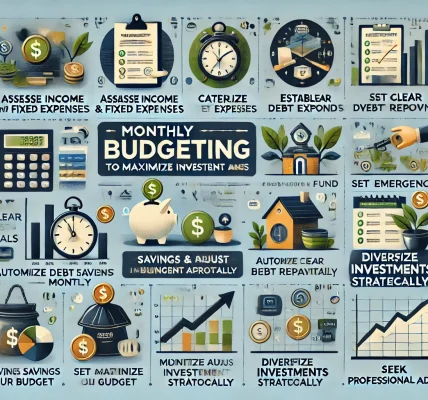Setting financial goals is the cornerstone of achieving financial success. Whether you’re aiming to save for a vacation, pay off debt, or build an emergency fund, having clear and realistic financial goals is essential. Once you’ve set these goals, aligning your budget to support them is crucial to turning your plans into reality. A well-crafted budget helps you track your spending, save more, and keep your financial goals within reach.
In this blog, we’ll guide you through the process of setting financial goals and aligning your budget accordingly, so you can stay on track and make the most out of every dollar.
Why Setting Financial Goals Is Crucial
Financial goals give you direction. They provide a clear roadmap for where you want to go with your money and help you stay motivated along the way. Having specific goals makes it easier to prioritize your spending and focus on what truly matters.
Here are some key benefits of setting financial goals:
- Clarity and Purpose: When you set clear goals, you have a specific target to work towards, which makes managing your finances easier.
- Increased Motivation: Achieving milestones along the way keeps you motivated and committed to your financial plan.
- Better Spending Decisions: With goals in place, you’re more likely to think twice before making impulsive purchases, helping you stay on track with your budget.
- Improved Financial Discipline: Financial goals encourage you to live within your means and save for the future, fostering healthy financial habits.
Step-by-Step Guide to Setting Your Financial Goals
1. Identify Your Financial Priorities
The first step in setting your financial goals is to determine what matters most to you. Do you want to pay off high-interest debt? Build an emergency fund? Save for a home or retirement? Identifying your priorities is crucial because it gives you a clear sense of direction.
- Short-Term Goals (1-3 years): These might include paying off credit card debt, building an emergency fund, or saving for a vacation.
- Medium-Term Goals (3-5 years): These could involve saving for a home down payment, investing in education, or planning for a wedding.
- Long-Term Goals (5+ years): Long-term goals typically include retirement savings, building wealth through investments, or creating a legacy for your family.
2. Set SMART Goals
To ensure your financial goals are effective, make them SMART:
- Specific: Clearly define the goal. Instead of saying, “I want to save money,” say, “I want to save $5,000 for a down payment on a house.”
- Measurable: Quantify your goal so you can track your progress.
- Achievable: Make sure the goal is realistic based on your income and expenses.
- Relevant: Ensure the goal is aligned with your long-term objectives and values.
- Time-bound: Set a deadline to help you stay focused and committed.
For example, a SMART goal could be: “I will save $3,000 in the next 12 months for a vacation to Europe.”
3. Break Down Large Goals into Smaller Milestones
Large goals can feel overwhelming, but breaking them down into smaller, more manageable steps makes them feel achievable. If your goal is to save $10,000 for a home down payment within five years, break it down to smaller monthly or annual savings targets. This gives you clear milestones to hit and helps keep you on track.
For instance, to save $10,000 in 5 years, you need to save about $200 a month. You can even set quarterly milestones, such as saving $2,500 every three months, which gives you an opportunity to celebrate your progress and adjust as needed.
4. Assess Your Current Financial Situation
Before you can align your budget with your goals, it’s important to assess your current financial situation. Take a deep dive into your income, expenses, debts, and savings. This will help you understand how much you can realistically allocate toward your goals each month.
Ask yourself:
- What is my monthly income after taxes?
- What are my monthly expenses (rent, utilities, groceries, etc.)?
- Do I have any outstanding debts that need to be paid off?
- How much do I already have saved, and what’s the gap to reach my goal?
Once you have a clear understanding of where you stand, you can start planning how to allocate money toward your goals.
How to Align Your Budget with Your Financial Goals
Once you’ve set your goals, the next step is aligning your budget to support them. Here’s how to do that effectively:
1. Prioritize Your Goals
Not all goals can be achieved simultaneously, especially if you have limited resources. Prioritize your goals based on urgency and importance. For example, building an emergency fund should take precedence over saving for a vacation if you don’t have sufficient savings to cover unexpected expenses.
You can use the 50/30/20 rule to guide your budget:
- 50% for Needs: Essentials such as rent, utilities, groceries, and insurance.
- 30% for Wants: Discretionary spending like dining out, entertainment, and hobbies.
- 20% for Savings and Debt Repayment: This portion should be allocated to paying down debt and saving for your financial goals.
2. Adjust Spending Habits
Once you know where your money is going, look for areas where you can cut back to free up more funds for your goals. For example:
- Cut back on non-essential subscriptions: Streaming services, magazines, or memberships that aren’t being used regularly.
- Limit dining out: Cooking at home or packing lunches can save a significant amount over time.
- Evaluate your utility bills: Reducing energy consumption can lower your monthly expenses.
By cutting back on unnecessary spending, you can direct more money toward your financial goals.
3. Automate Your Savings
One of the best ways to align your budget with your financial goals is by automating your savings. Set up automatic transfers from your checking account to your savings account, retirement account, or investment account each month. By making savings automatic, you won’t be tempted to spend the money elsewhere.
You can automate:
- Emergency fund savings.
- Contributions to retirement accounts (such as 401(k) or IRA).
- Payments toward debt or loans.
4. Track and Review Your Progress Regularly
Your financial goals and budget should evolve over time. Regularly track your progress to see if you’re on pace to meet your goals. If you’re falling behind, assess what changes need to be made to your spending habits or savings plan. Adjust your budget as needed to stay on track.
Final Thoughts
Setting financial goals is the first step toward taking control of your money and securing your future. By following the steps outlined above, you can align your budget with your goals, track your progress, and make smarter financial decisions. Remember, consistency and discipline are key to achieving long-term financial success.




